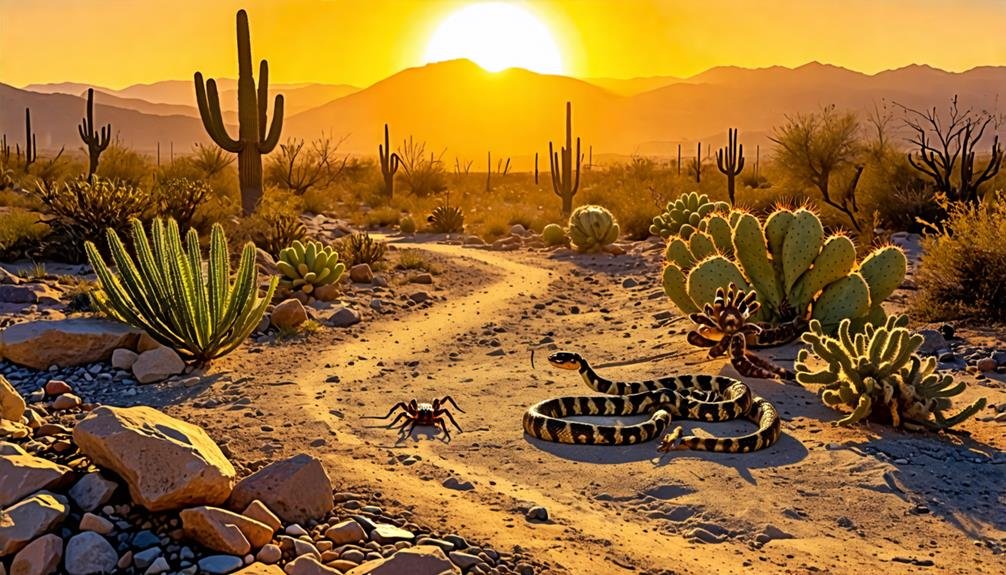When exploring California's deserts, it's important to watch for certain creatures that can pose risks. Venomous snakes like the Mojave Green and Western Diamond-Back can be hidden in rocky areas. Scorpions, including the Bark Scorpion, and spiders such as the Black Widow are also present. Unique reptiles like the Gila Monster require caution as well. Predatory animals like mountain lions and bobcats inhabit this region. Staying aware of these creatures and taking preventive measures, such as wearing sturdy boots and checking for ticks, will improve your safety. You'll come across more crucial tips for a safe adventure ahead.
Venomous Snakes
California's arid landscapes host various species of poisonous serpents, notably the perilous Mojave Green Rattlesnake and the Western Diamond-Back Rattlesnake. These reptiles present considerable threats to unsuspecting trekkers and nature lovers. The Mojave Green Rattlesnake, distinguished by its vivid green coloration and diamond-patterned scales, generally measures between 2 to 4.5 feet in length. This serpent is predominantly active in the cooler evening hours, emphasizing the need for explorers to remain alert during their outings.
In a similar vein, the Western Diamond-Back Rattlesnake is extremely venomous and can grow up to 7 feet long. Its unique triangular head and diamond-shaped scale pattern aid in its identification amid the desert surroundings. Recognizing the existence of these rattlesnakes is vital, as they may strike when they feel threatened.
Beyond rattlesnakes, the desert is also inhabited by fascinating creatures like the Gila Monster, a venomous lizard known for its excruciating bite. Although the presence of venomous snakes and other hazardous wildlife may be intimidating, knowledge and awareness are essential. By respecting their environments and exercising caution, you can appreciate the allure of California's deserts while reducing potential dangers.
Venomous Arthropods
California's deserts are home to various venomous arthropods, presenting unique dangers for locals and tourists. The Bark Scorpion, the most venomous scorpion in the United States, is a prominent example. With a tan exterior and a darker abdomen, it blends seamlessly into the desert floor. As a nocturnal predator, it often seeks refuge under logs and stones, making it essential to exercise caution when navigating its environment.
Another significant venomous species is the Black Widow Spider. Its glossy black body and the iconic red hourglass marking on its abdomen make it easily identifiable. While bites are infrequent, they can result in severe symptoms. Knowing where these spiders prefer to hide—such as in wood piles or shadowy corners—can help prevent encounters.
Additionally, the Tarantula Hawk Wasp stands out with its vivid metallic blue-black coloration. It is known for delivering one of the most excruciating stings among insects. Despite its intimidating sting, this wasp is generally non-aggressive and will only strike when threatened. By understanding and respecting these creatures, visitors can enjoy a safe adventure in the captivating deserts of California.
Unique Reptiles
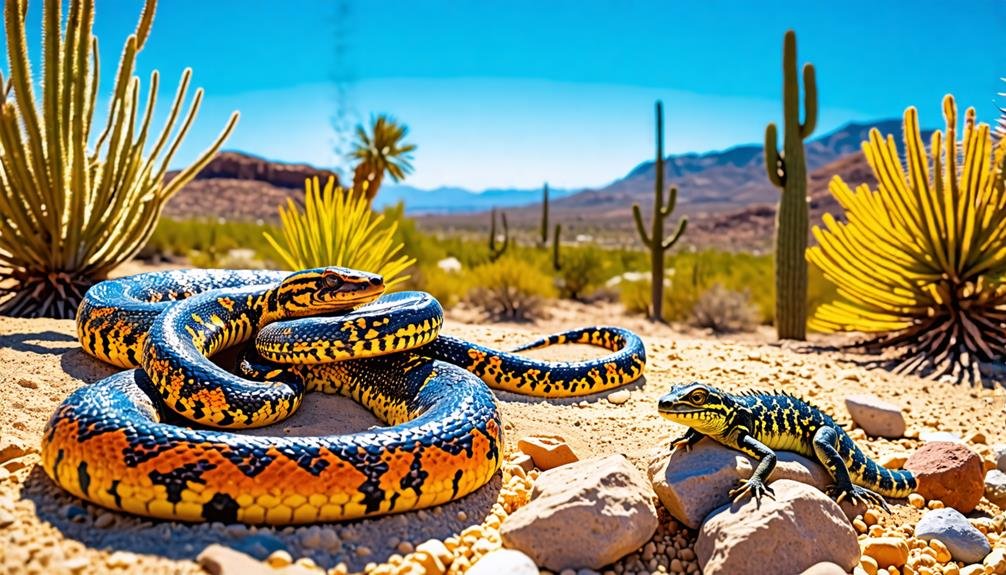
Unique reptiles inhabit the arid landscapes of California deserts, showcasing remarkable adaptations for survival. The Gila Monster, a prominent lizard species in the United States, features vibrant, bead-like scales and possesses a venomous bite. Its striking appearance is both enchanting and formidable. Although the venom can inflict intense pain, Gila Monsters typically exhibit non-aggressive behavior and prefer retreat when threatened.
Another remarkable resident is the Desert Tortoise, a slow-moving herbivore adapted to the harsh desert environment. This protected species plays a crucial role in the ecosystem by feeding on native flora and assisting in seed dispersal. The Desert Tortoise has an impressive lifespan, often living for decades, and its burrows offer shelter to various desert inhabitants.
Both the Gila Monster and Desert Tortoise possess distinct traits that captivate observers. They serve as reminders of the importance of respecting wildlife. Observing these reptiles from a safe distance enhances our appreciation for their roles in the desert ecosystem while ensuring personal safety. Awareness and understanding foster a harmonious coexistence with California's extraordinary reptilian inhabitants.
Dangerous Insects
California's deserts are home to several hazardous insects that can pose risks to humans and animals. Africanized Honey Bees, commonly referred to as Killer Bees, exhibit aggressive behavior, particularly when threatened. They swarm in large numbers, and their stings can elicit severe allergic reactions in certain individuals. If you find yourself near a swarm, staying calm and quickly vacating the area can help prevent an attack.
Another insect to be cautious of is the Common Desert Centipede. This creature possesses a painful bite that can result in nerve damage in some instances. While centipedes are generally non-aggressive, they will defend themselves if they feel disturbed. To avoid bites, wearing durable footwear and being cautious about hand placement is advisable.
Kissing Bugs, which can also be found in California's deserts, are known to transmit Chagas disease, a potentially serious illness. These insects typically hide in crevices or beneath rocks. Although they do not bite often, it's important to avoid direct contact. By familiarizing yourself with these insects and taking necessary precautions, you can enhance your safety while enjoying the stunning landscapes of California's deserts.
Predatory Birds and Animals
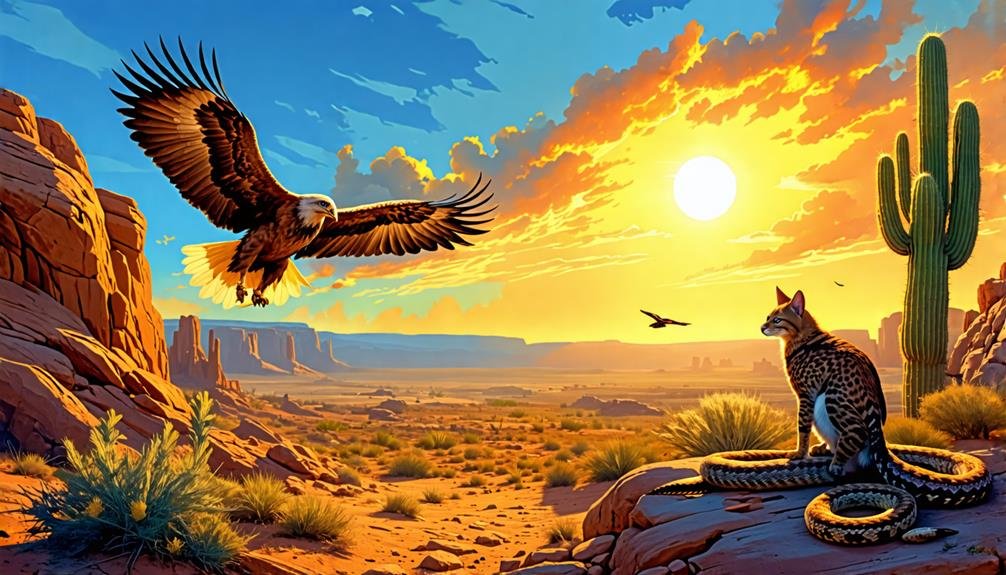
Predatory birds and animals inhabit California's desert ecosystems, playing a vital role in maintaining ecological balance. Species such as red-tailed hawks and golden eagles, along with the nimble Coachwhip Snake, regulate populations of smaller mammals and reptiles, which sustains the intricate food web. With their keen vision and agile flight, these avian hunters seek out rodents and lizards, preventing overpopulation of any single species.
Among the iconic residents of these arid landscapes is the Desert Bighorn Sheep. These majestic ungulates are perfectly adapted to navigate rocky terrains, often seen skillfully ascending steep cliffs. Their presence signifies a thriving ecosystem, as they serve as prey for apex predators like mountain lions and coyotes.
Though these predators may evoke fear, they are essential for the desert's health. Recognizing their importance can help ease worries about potential encounters during outdoor excursions. Witnessing these awe-inspiring creatures in their native habitats fosters a sense of wonder and freedom, highlighting the interconnectedness of life within the desert. By approaching this environment with respect and caution, one can fully appreciate the beauty and complexity of California's desert ecosystems.
Wildcats
Wildcats, such as the bobcat and mountain lion, are vital in maintaining the ecological balance of California's desert ecosystems. These elegant animals control populations of smaller mammals, thus supporting the health of their habitats. The bobcat, known for its distinctive tufted ears and short tail, adapts well to various environments, including arid landscapes. It skillfully hunts rodents and rabbits, helping to regulate these populations.
Conversely, the mountain lion, or cougar, is a larger and more formidable wildcat. This apex predator traverses extensive territories, primarily preying on deer and other hoofed mammals. Both the bobcat and mountain lion are designated protected species in California, underscoring the need to respect their natural environments.
While encounters with these wildcats are rare, it is crucial to stay vigilant during desert excursions. Respect their territory, as they play an essential role in the ecosystem. By learning about their behaviors and habitats, you can appreciate the wild allure of California's deserts while ensuring your safety and the conservation of these magnificent creatures.
Potential Health Risks
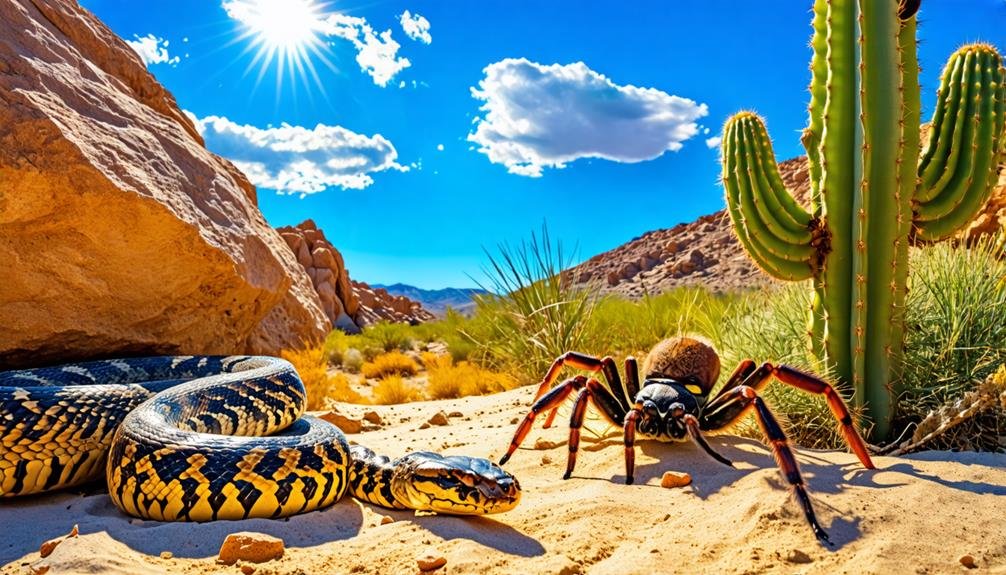
In the California deserts, potential health risks arise from creatures like kissing bugs and ticks. Kissing bugs can transmit Chagas disease, a condition that may lead to serious health issues if left untreated. Likewise, ticks are common parasites that can carry diseases such as Lyme disease, so it's crucial to take precautions when exploring these natural environments.
Kissing Bugs Dangers
Kissing bugs present serious health dangers due to their role as vectors for Chagas disease, a potentially severe condition that can result in long-lasting health problems. This illness, spread through the feces of kissing bugs, may lead to cardiovascular and gastrointestinal complications if not addressed. It is crucial to recognize the presence of these insects in California's desert regions.
To enhance your awareness, consider these three essential aspects regarding kissing bugs and their health implications:
- Transmission: Kissing bugs often bite humans during sleep, which increases the risk of coming into contact with their feces that might harbor the Trypanosoma cruzi parasite responsible for Chagas disease.
- Symptoms: Early signs of Chagas disease may encompass fever, lethargy, and localized swelling at the site of the bite. Without treatment, the condition can evolve into serious complications, impacting the heart and digestive tract.
- Prevention: To minimize the likelihood of encountering kissing bugs, maintain cleanliness in living spaces, seal gaps in your home, and refrain from sleeping outdoors without adequate protection.
While the dangers are significant, being informed allows you to implement preventative strategies. Stay vigilant, but enjoy your desert activities with assurance.
Tick-Borne Diseases
Ticks in California's deserts present significant health hazards. These parasites transmit various diseases that can negatively impact human well-being. Ticks flourish in grassy and brushy landscapes, so it is vital for outdoor enthusiasts to exercise caution. Lyme disease, a prominent tick-borne illness, leads to symptoms such as fever, fatigue, and joint pain if not treated promptly. Another serious concern is Rocky Mountain spotted fever, which manifests through intense headaches, rashes, and potentially severe complications.
To reduce the likelihood of tick bites, wear long-sleeved shirts and pants and apply insect repellent with DEET. It is wise to stick to designated paths and steer clear of tall grasses or dense vegetation where ticks may be hiding. After your outdoor activities, conduct a thorough inspection of your body and clothing for ticks, paying close attention to warm, protected areas like armpits and behind knees.
Although the idea of ticks can be daunting, being knowledgeable and prepared significantly lowers health risks. By following simple precautions, you can appreciate the stunning landscapes of California's deserts while protecting your health from tick-borne illnesses. Stay educated, stay secure, and enjoy the freedom of outdoor adventures responsibly.
Safety Concerns
In California deserts, awareness of safety concerns regarding venomous creatures is crucial for a safe outdoor experience. Rattlesnakes, scorpions, and black widow spiders are among the notable risks; knowing how to identify them and understanding their behaviors can help prevent dangerous encounters. For instance, wearing sturdy boots can protect against snake bites, while being cautious at night can reduce the likelihood of scorpion stings.
Venomous Snakes Awareness
Awareness of the three main venomous serpents in California's desert regions—the Mojave Green Rattlesnake, the Western Diamond-Back Rattlesnake, and the Sidewinder Rattlesnake—is essential for ensuring safety while exploring these environments. Understanding their behaviors and habitats can significantly decrease the likelihood of encounters.
Here are three crucial safety recommendations to consider:
- Stay Vigilant: Always be aware of your surroundings, particularly during early morning and late evening when rattlesnakes are most active. Be cautious where you step and sit to prevent unexpected encounters.
- Wear Appropriate Footwear: Sturdy hiking boots can offer essential protection against snake bites. Avoid sandals and open-toed shoes, which leave your feet exposed.
- Educate Yourself: Become familiar with the characteristics of rattlesnakes, scorpions, and black widow spiders. Recognizing these creatures can help you avoid dangerous situations in the wilderness.
Scorpion Encounters Precautions
Understanding the hazards associated with scorpions is essential for anyone venturing into California's deserts. These arachnids are primarily active at night and often conceal themselves under stones and logs. To ensure a safe exploration, it is crucial to implement effective strategies to avoid scorpion encounters.
First, always don sturdy hiking boots and long trousers when trekking or walking in these environments. This straightforward step can significantly reduce the chances of stings from camouflaged scorpions. When taking a break, inspect the ground before sitting and refrain from placing backpacks or equipment directly on the sand or rocks, as scorpions may be hiding underneath.
During the evening, utilize a reliable flashlight to light your way, since scorpions tend to be more active after dark. If you happen to encounter a scorpion, maintain a safe distance and do not try to touch it. In the event of a sting, stay composed; while most scorpion stings are not lethal, they can be quite painful. Seek medical assistance if you experience severe reactions, such as difficulty breathing or significant swelling.
Spider Bite Risks
Encounters with spider bites, especially from the venomous Black Widow Spider, present considerable health hazards for individuals exploring California's deserts. Although such incidents are uncommon, being aware of the potential risks can aid adventurers in ensuring their safety and enhancing their outdoor experiences.
- Black Widow Spider: This arachnid, identified by its glossy black exoskeleton and unique red hourglass marking, can inflict a painful bite that may lead to serious symptoms, such as muscle spasms and gastrointestinal distress.
- Tarantula Hawk Wasp: While technically not a spider, this large wasp is notorious for its excruciating sting, often considered among the most severe in the insect kingdom. It preys on tarantulas, serving as a reminder of the desert's fascinating ecosystem.
- Scorpionfly: This benign insect sports a scorpion-like appendage but poses no danger to humans. Its intriguing look can captivate explorers, offering a glimpse into the rich biodiversity of California's desert regions.
To reduce risks, it is advisable to don gloves when reaching into concealed areas and to shake out garments before wearing them. Taking these precautions can help ensure a safer and more enjoyable desert expedition.
Precautions and Safety Measures
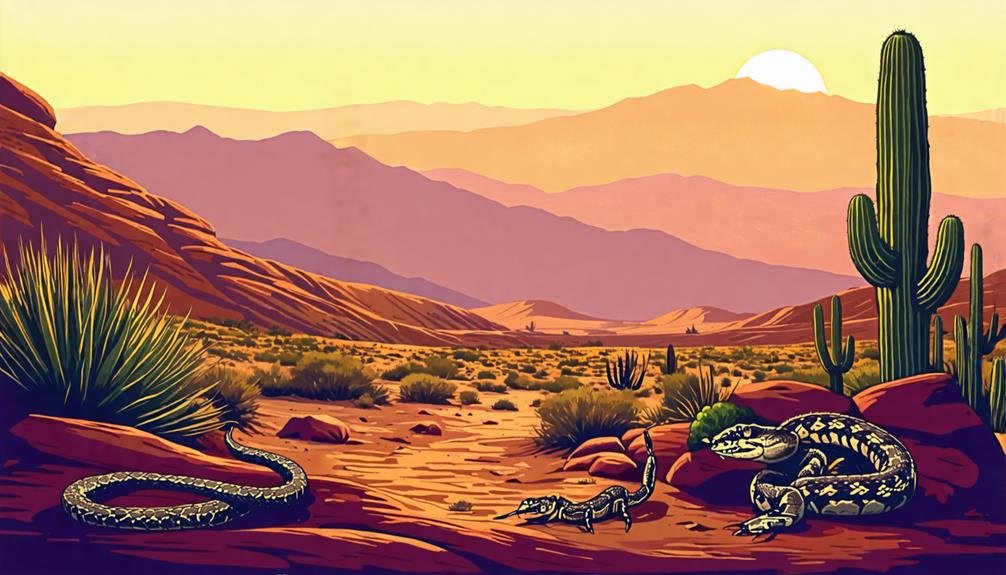
Taking appropriate precautions is essential for safely exploring the varied and potentially hazardous wildlife in California's desert regions. When navigating these arid terrains, be mindful of the Gila Monster, a venomous reptile recognized for its painful bite. It is important to maintain a safe distance from these lizards, as they may exhibit aggression when threatened. Wearing rugged hiking boots and long pants can offer additional protection against bites and scratches.
Always remain on designated trails to minimize the chance of encountering venomous serpents, such as the Mojave Green Rattlesnake or the Western Diamondback Rattlesnake. These snakes are typically more active during the cooler evening hours, so planning your excursions for daytime can enhance safety. Carry a well-stocked emergency kit and familiarize yourself with first aid procedures in case of a snake bite. If bitten, seek medical assistance without delay.
Additionally, be vigilant of other desert inhabitants, including scorpions and black widow spiders. Check your surroundings before sitting or placing your gear down. By adhering to these safety measures and staying aware of your environment, you can confidently appreciate the stunning landscapes of California's deserts.

